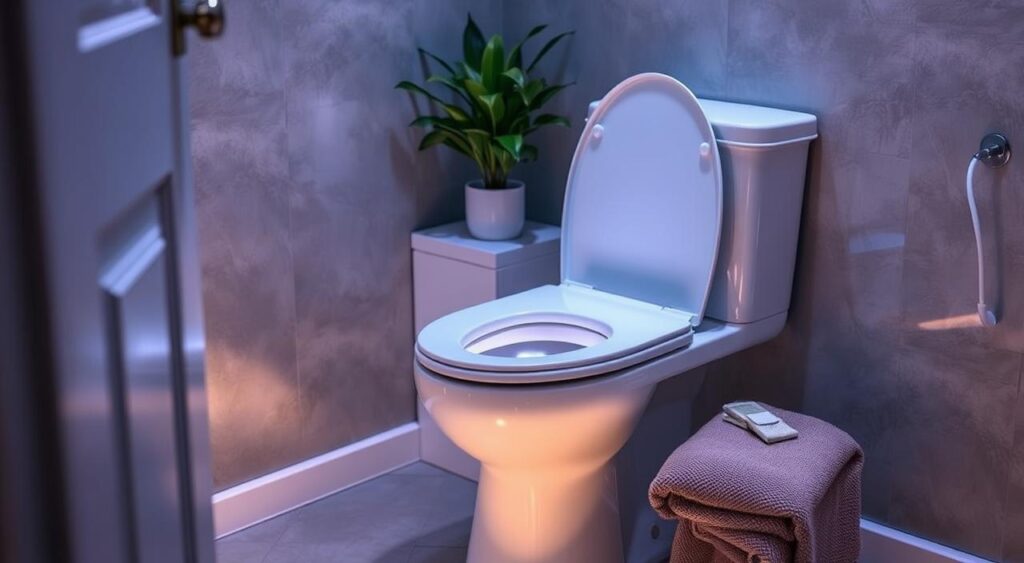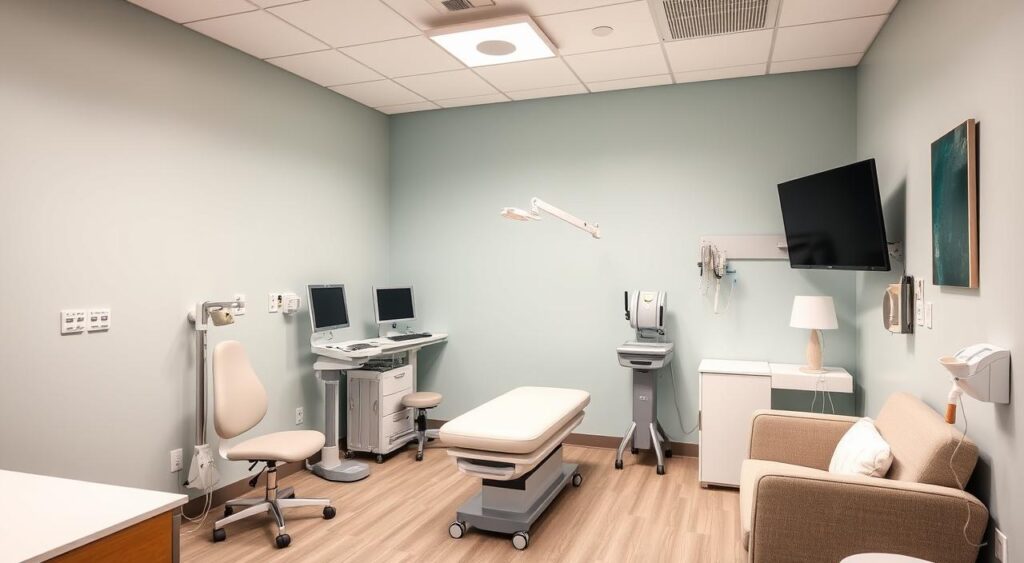Effective tips for managing urinary incontinence and improving quality of life. Learn practical strategies to regain bladder control.
Urinary incontinence: Women are twice as likely as men to face this issue. It happens when you can’t control your bladder, caused by weak muscles, neurological problems, or some medicines. It’s key to manage it well to avoid more problems and improve life quality.

First, understand what urinary incontinence is and why it happens. Knowing this helps you plan how to handle it. You can make lifestyle changes, do pelvic floor exercises, and get medical help when needed.
Key Takeaways
- Urinary incontinence affects millions of adults in the United States, with women being more likely to experience it.
- Incontinence causes can include weakened pelvic muscles, neurological disorders, and certain medications.
- Effective management of urinary incontinence is crucial to prevent complications and improve quality of life.
- Lifestyle modifications, such as dietary changes and exercise, can help alleviate symptoms of urinary incontinence.
- Seeking medical treatment and support is essential for developing a comprehensive management plan.
- Urinary incontinence can be managed and treated with the right approach and resources.
Understanding Urinary Incontinence and Its Impact
Urinary incontinence affects millions globally, causing daily life disruptions. It’s crucial to know the types, like stress, urge, and mixed incontinence. Symptoms include urinary urgency and overactive bladder.
This condition impacts quality of life, leading to emotional distress and social isolation. Physical effects include skin irritation and urinary tract infections.
Different Types of Urinary Incontinence
- Stress incontinence: leakage of urine during physical activity or coughing
- Urge incontinence: leakage of urine due to a sudden, intense need to urinate
- Mixed incontinence: combination of stress and urge incontinence
Common Causes and Risk Factors
Many factors can lead to urinary incontinence, like pregnancy and menopause. Age, obesity, and medical conditions also play a role. Knowing these helps in preventing and treating urinary urgency and overactive bladder.
| Type of Urinary Incontinence | Common Causes | Risk Factors |
|---|---|---|
| Stress Incontinence | Pregnancy, childbirth, menopause | Age, obesity |
| Urge Incontinence | Neurological disorders, diabetes | Age, certain medications |
Essential Lifestyle Modifications for Bladder Control
Managing urinary incontinence needs a mix of lifestyle changes to help with leakage prevention and urinary control. Keeping a healthy weight, stopping smoking, and cutting down on caffeine and alcohol can help a lot. For example, a healthy weight eases pressure on the bladder, and quitting smoking boosts urinary health.
Regular exercise is also key for better bladder control. Doing Kegel exercises strengthens the pelvic floor muscles, helping with urinary control and leakage prevention. Plus, activities like walking or swimming can enhance bladder health.
- Maintaining a healthy weight to reduce pressure on the bladder
- Quitting smoking to improve overall urinary health
- Reducing caffeine and alcohol intake to minimize bladder irritation
- Incorporating physical activity and exercise to improve pelvic floor muscle strength
By making these lifestyle changes part of your daily life, you can actively manage urinary incontinence. This leads to better leakage prevention and urinary control.
| Lifestyle Modification | Benefits for Bladder Health |
|---|---|
| Maintaining a healthy weight | Reduces pressure on the bladder, improving urinary control |
| Quitting smoking | Improves overall urinary health, reducing the risk of urinary incontinence |
| Reducing caffeine and alcohol intake | Minimizes bladder irritation, reducing the risk of leakage |
The Role of Pelvic Floor Exercises in Managing Incontinence
Pelvic floor exercises are key in treating incontinence. They strengthen muscles that support the bladder and urethra. Doing these exercises daily can help control your bladder and prevent leaks. First, learn how to find and use your pelvic floor muscles correctly.
It’s important to do pelvic floor exercises right. You should squeeze the muscles like you’re stopping urine flow, hold for a few seconds, and then release. Start with short sessions and gradually increase the time and frequency. Having a schedule can help you stay consistent.
Benefits of Pelvic Floor Exercises
- Improved bladder control
- Reduced likelihood of leaks
- Enhanced overall pelvic health
Keeping track of your progress is crucial. Monitoring your improvements can keep you motivated. You might set goals, celebrate milestones, and get help from a healthcare professional if needed. Combining pelvic floor exercises with other treatments can greatly improve your life.
| Exercise Frequency | Exercise Duration | Progress Tracking |
|---|---|---|
| Daily | 10-15 minutes | Weekly journal entries |
| 3-4 times a week | 5-10 minutes | Monthly progress reviews |
Dietary Changes to Reduce Bladder Leakage
Making dietary changes can help reduce bladder leakage. Some foods and drinks can make it worse, while others can help. Drinking more water is key to prevent constipation, which can put pressure on the bladder.
Some foods and drinks that can irritate the bladder and worsen bladder leakage include:
- Caffeine
- Spicy foods
- Citrus fruits and juices
- Tomatoes and tomato-based products
Eating bladder-friendly foods can help. These include:
- Fiber-rich foods like whole grains, fruits, and vegetables
- Lean proteins like chicken, fish, and tofu
- Low-fat dairy products

Changing your diet can help with bladder leakage and improve bladder health. Remember, what works for one person might not work for another. Always talk to a healthcare professional for the best treatment plan.
Behavioral Techniques for Better Urinary Control
People with urinary urgency can find relief through various behavioral techniques. These methods help train the bladder to hold more urine. This reduces the need to go to the bathroom as often. By using these techniques daily, one can take back control of their bladder and lessen urgency.
Research shows that behavioral methods, like bladder training, work well for incontinence. Bladder training means slowly increasing the time between bathroom visits. This helps the bladder hold more urine, cutting down on frequent trips.
Effective Techniques for Urinary Control
- Timed voiding strategies: Voiding at set intervals to prevent urgency
- Double voiding technique: Voiding twice in a short interval to ensure the bladder is completely emptied
Using these techniques can help manage urinary urgency and enhance life quality. It’s crucial to talk to a healthcare expert before starting any new methods. This ensures they fit your specific needs.
With the right approach and techniques, overcoming urinary urgency is possible. Combining behavioral methods with lifestyle changes and other strategies can manage the condition well. This improves overall health and well-being.
Medical Treatments and Professional Support Options
For those dealing with ongoing urinary incontinence, medical help might be needed. Incontinence treatment can range from medicines to surgery. It’s key to get help from doctors like urologists and urogynecologists. They can offer tailored advice and treatment plans.
Some common treatments for urinary incontinence include:
- Medications to relax the bladder muscle and reduce spasms
- Injectable therapies to bulk up the urethral sphincter
- Surgical procedures, such as sling surgery or bladder suspension
Getting help from healthcare providers is vital for managing urinary incontinence. They can create a custom incontinence treatment plan. This might include lifestyle changes, behavioral techniques, and medical treatments. With professional support, people can better manage their bladder health and improve their life quality.

Managing Urinary Incontinence at Night
Dealing with urinary incontinence at night can be tough. To lessen its effects on sleep and daily life, it’s key to use leakage prevention methods.
Changing the bedroom can help a lot. Using waterproof mattress covers and absorbent pads can stop accidents from ruining the mattress. Also, a nightlight in the room helps wake up at night without falling.
Bedroom Environment Modifications
- Use protective bedding, such as waterproof mattress covers and absorbent pads
- Install a nightlight to facilitate nighttime awakenings
- Keep the bedroom at a comfortable temperature to reduce the need for nighttime awakenings
Evening Routine Adjustments
To cut down on nighttime incontinence, tweaking the evening routine is important. Drinking less water before bed, going to the bathroom right before sleep, and avoiding caffeinated and carbonated drinks can help.
| Evening Routine Adjustments | Benefits |
|---|---|
| Limit fluid intake before bedtime | Reduces the need for nighttime awakenings |
| Void immediately before sleep | Empties the bladder, reducing the risk of incontinence |
| Avoid caffeinated and carbonated beverages | Reduces bladder irritation and the need for nighttime awakenings |
By using these tips, people can better handle urinary incontinence at night. This improves sleep and daily life, and boosts overall well-being through leakage prevention.
Maintaining Social Activities Despite Incontinence
Living with urinary incontinence doesn’t mean you have to stop doing things you love. You can still enjoy social activities and hobbies. It just takes some planning and creativity to manage urinary incontinence while doing so.
Traveling with urinary incontinence can be easier with some strategies. Pack extra clothes, find restrooms easily, and take breaks to use the bathroom. Some people also wear protective garments like adult diapers or pads to avoid accidents.
Travel Tips and Preparation
- Research restrooms and bathroom facilities at destinations
- Pack a small bag with essentials, such as extra clothing and wipes
- Consider wearing protective garments, such as adult diapers or pads
Adapting exercise and sports to urinary incontinence is possible. Wearing protective gear or using special equipment can make you feel more secure. Remember to listen to your body and take breaks to use the bathroom.
Social Situation Management
Managing urinary incontinence in social situations needs planning, creativity, and confidence. Being prepared and taking precautions can help you enjoy activities without worry. With the right approach, urinary incontinence shouldn’t stop you from living fully.
| Strategy | Description |
|---|---|
| Packing extra clothing | Having a change of clothes on hand in case of an accident |
| Wearing protective garments | Using adult diapers or pads to prevent accidents |
| Taking regular breaks | Using the bathroom regularly to prevent accidents |
Products and Tools for Incontinence Management
Knowing incontinence causes helps pick the right products and tools. There are many options, like absorbent pads and adult diapers. These can make people with incontinence feel more comfortable and confident.
Some important products and tools for managing incontinence include:
- Absorbent products, such as pads and adult diapers
- Devices that help with bladder control, like catheters and urinary collectors
- Protective garments, such as underwear and pants with built-in absorbent layers
Choosing the right products and tools depends on the incontinence causes. For stress incontinence, bladder control devices might be best. For urge incontinence, absorbent products could be better.
Understanding the different products and tools helps people with incontinence manage their condition better. It’s key to talk to a healthcare professional. They can help find the best products and tools, considering the incontinence causes.
Conclusion: Taking Control of Your Bladder Health
Managing urinary incontinence needs a full approach. It involves understanding the causes and using different treatments. Knowing about bladder leakage and its risks helps people take action to control their bladder better.
Effective management comes from making lifestyle changes, doing pelvic floor exercises, and using behavioral techniques. A healthy diet, Kegel exercises, and bladder training can help control bladder issues and reduce leakage.
You’re not alone in dealing with urinary incontinence. Getting help from doctors, joining support groups, and trying incontinence products can be very helpful. These steps can improve your bladder health and enhance your life quality.
FAQ
Q: What is urinary incontinence?
A: Urinary incontinence is when you leak urine without meaning to. It happens to many people, especially women and older adults.
Q: What are the different types of urinary incontinence?
A: There are a few types. Stress incontinence happens when you leak urine during activity. Urge incontinence is when you suddenly need to go. Mixed incontinence is a mix of both.
Q: What are the common causes and risk factors of urinary incontinence?
A: Pregnancy, childbirth, and menopause can cause it. So can prostate issues in men and weakened muscles. Obesity, chronic coughing, and some medicines also increase the risk.
Q: How does urinary incontinence affect physical and emotional well-being?
A: It can really affect you. You might get skin irritation, UTIs, and feel embarrassed. It can also make you anxious, depressed, and lonely.
Q: What lifestyle modifications can help manage urinary incontinence?
A: To help, stay healthy, quit smoking, and cut down on caffeine and alcohol. Regular exercise and pelvic floor exercises are also good.
Q: How do pelvic floor exercises, or Kegel exercises, help with incontinence?
A: Kegel exercises strengthen the muscles around your bladder and urethra. This helps control your bladder and reduce leaks. Doing them right and regularly is key.
Q: What dietary changes can help reduce bladder leakage?
A: Drinking more water helps prevent constipation. Avoiding caffeine and spicy foods is also good. Eating foods that are good for your bladder can help too.
Q: What are some behavioral techniques for better urinary control?
A: Techniques like bladder training and timed voiding can help. The double voiding technique is another option. These methods can help you control your bladder better.
Q: What medical treatments are available for urinary incontinence?
A: Treatments include medicines and surgery for severe cases. It’s important to talk to a healthcare provider to find the right treatment for you.
Q: How can I manage urinary incontinence at night?
A: Use protective bedding and a nightlight in your bedroom. Limit fluids before bed and go to the bathroom right before sleeping.
Q: How can I maintain social activities despite living with urinary incontinence?
A: Plan ahead for outings and exercise. Learn how to manage incontinence in social situations. This way, you can enjoy activities without letting incontinence stop you.
Q: What products and tools are available for incontinence management?
A: There are many products like pads and adult diapers. There are also devices to help with bladder control. Choosing the right one depends on your specific situation.
